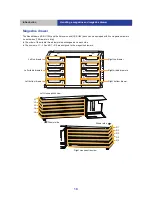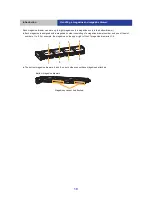
4
Introduction
Overview of functions
The Panasonic DATA ARCHIVER LB-DH7 series is a high-capacity storage library device using
optical discs.
The basic library device system of the LB-DH7 series consists of one Base Module (LB-DH70A),
one Bottom Module (LB-DF81), and one Extension Module (LB-DF72A, with the Writer Unit).
The Base Module, which serves as the centerpiece of the system, is connected to other modules with the exclusive
use connection cables to exchange control signals with external servers. Also designed for magazine storage, it can
accommodate up to 76 magazines.
In addition, the Base Module has tree built-in drives that read and write data and two SAS interface ports.
The Bottom Module has a function that takes the optical discs of magazines stored in each module in and out of
drives, and a scanner that reads the RFID tags built into magazines and the 1D or 2D code labels attached to
magazines.
The Extension Module (with the Writer Unit) houses the Writer Unit LB-XD73A in its Extension Unit LB-XH82.
The Magazine Unit is designed for magazine storage and can accommodate up to 76 magazines.
The Writer Unit has three built-in drives that read and write data and two SAS interface ports.
It can also be connected to the Base Module and Extension Unit.
The basic system includes six drives (three in the Base Module and another three in the Extension Module with the
Writer Unit). These six drives make up and work as one drive system.
The DATA ARCHIVER LB-DH7 series can increase the number of magazines stored or have
multiple drive systems by adding the Extension Module (with a Writer Unit) or Extension Module
(without a Writer Unit) LB-DH82.
The Extension Module (without a Writer Unit) is a combination of the Extension Unit integrated with Control Unit LB-
XC82.
The Control Unit does not house drives. It is only has a function that connects the Base Module and Magazine
Extension Unit.
Supported magazines
Two types of magazines, those with capacity of 3.6 TB and those with a capacity of 1.2 TB, are supported. (Both
values are for unformatted)
Each magazine houses a built-in HF-band RFID tag. When you pull out a magazine drawer of a module, store,
replace or remove a magazine, and then close the magazine drawer, the scanner performs RFID reading within the
system, providing information on magazines stored in the system.



































